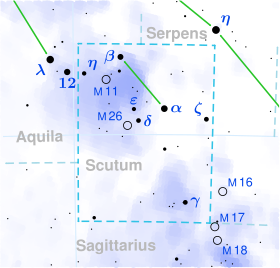Epsilon Scuti
Star in the constellation Scutum From Wikipedia, the free encyclopedia
Epsilon Scuti, Latinized from ε Scuti, is a probable astrometric binary [9] star system in the constellation Scutum. It is faintly visible to the naked eye with an apparent visual magnitude of +4.88.[2] Based upon an annual parallax shift of 5.71 mas as seen from Earth,> it is located approximately 570 light years from the Sun. It is moving closer to the Sun with a radial velocity of −9.8 km/s.[6] Epsilon Scuti was a latter designation of 3 Aquilae.[10]
| Observation data Epoch J2000 Equinox J2000 | |
|---|---|
| Constellation | Scutum |
| Right ascension | 18h 43m 31.251s[1] |
| Declination | −8° 16′ 30.77″[1] |
| Apparent magnitude (V) | 4.88[2] |
| Characteristics | |
| Spectral type | G8IIb[3] |
| U−B color index | +0.88[4] |
| B−V color index | +1.12[5] |
| Astrometry | |
| Radial velocity (Rv) | −9.8±0.6[6] km/s |
| Proper motion (μ) | RA: +21.781[1] mas/yr Dec.: +4,591[1] mas/yr |
| Parallax (π) | 5.7100±0.1842 mas[1] |
| Distance | 570 ± 20 ly (175 ± 6 pc) |
| Absolute magnitude (MV) | -1.18[2] |
| Details | |
| Luminosity | 403[2] L☉ |
| Surface gravity (log g) | 1.00[7] cgs |
| Temperature | 4,500[7] K |
| Metallicity [Fe/H] | +0.05[2] dex |
| Rotational velocity (v sin i) | 5.1[8] km/s |
| Other designations | |
| ε Sct, 3 Aquilae, BD−08°4686, FK5 702, GC 25610, HD 173009, HIP 91845, HR 7032, SAO 142546, ADS 11601, CCDM J18435-0817A, WDS J18435-0817A, GSC 05692-02504 | |
| Database references | |
| SIMBAD | data |
The visible component is a yellow-hued bright giant with a G-type bright giant[3] It is radiating 403[2] times the Sun's luminosity from its photosphere at an effective temperature of 4,500 K.[7] Epsilon Scuti has at least three faint visual companions, two 14th magnitude stars, B and D, separated from the primary by 13.6 and 15.4 arcseconds respectively, and the 13th magnitude C, which is 38 arcseconds away.[11]
References
Wikiwand - on
Seamless Wikipedia browsing. On steroids.

